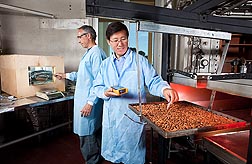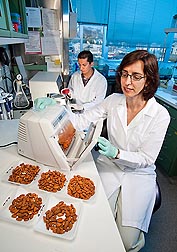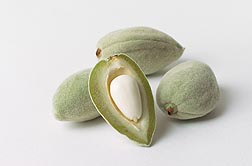Infrared Heating: Hot Idea for Keeping Almonds Safe To Eat
|
|
Crisp, crunchy almonds make a tasty and nutritious snack any time.
In Albany, California, investigators Zhongli Pan and Maria T. Brandl are collaborating in leading-edge studies that explore the use of a still-evolving technology, infrared heating, to help make sure almonds remain safe to eat.
The federal government, the U.S. almond industry, and food safety researchers are keeping an especially watchful eye on Salmonella enterica.
It’s generally thought that almonds are not naturally contaminated with high levels of this pathogen. Nevertheless, all almonds processed for sale in the United States today have to be pasteurized in order to zap Salmonella. The pasteurization procedure has to be powerful enough to reduce Salmonella population levels by a 4-log minimum. That’s a 10,000-fold decrease.
Nearly half a dozen methods already have federal approval for accomplishing this mandatory pasteurization. But many almond processors remain eager to learn about promising new options, including infrared heating. Pan, an engineer with ARS’s Western Regional Research Center in Albany, says several processors have expressed an interest in the series of infrared heating studies that he and Brandl, a microbiologist at the center, began in 2006.
The Many Advantages of Infrared
Pan says that infrared heating “doesn’t require use of any chemicals and offers a simple, safe, energy-efficient, and environmentally friendly way to kill Salmonella while almonds are still at the packinghouse.”
Pan is confident that the laboratory procedures developed with Brandl will be easy to scale up for commercial use. The researchers’ batch-based processes could, for example, be upgraded to a continuous-flow regime suited for the conveyor-belt-based processing that’s standard at most almond packinghouses today. Most of those processing plants are located in California, where all of America’s commercial almonds—a whopping 80 percent of the world’s supply—are grown.
Some packinghouses already use infrared heating, but not for pasteurizing. Instead, it’s part of a wet/dry process to remove almonds’ paper-thin skin, or pellicle, for certain almond products.
Infrared has other food applications, as well. Infrared grills and ovens, for instance, can be found in professional and home kitchens alike.
The idea of using infrared heating to kill germs isn’t new. But studies by the two California scientists are likely the most comprehensive investigations of the use of infrared heating to pasteurize almonds and knock down Salmonella populations to levels generally recognized as safe.
Pan says infrared heating offers the promise of fast, reliable, and relatively economical pasteurization. According to results from dozens of volunteer taste testers (sensory panelists) who participated in the studies, infrared heating doesn’t detectably alter the mild taste, smooth texture, attractive appearance, or other characteristics that make almonds one of the country’s most perennially popular tree nuts.
Infrared heating is, essentially, natural. “When you sit near your fireplace, the waves of heat that you feel are infrared energy,” Pan says.
Electromagnetic and invisible, infrared waves are also “the same kind of radiant energy that we get from the sun.” For their experiments, the scientists determined that infrared works well for killing Salmonella on either roasted or raw almonds.
|
|
In their studies with shelled, roasted almonds, for example, the team targeted a “medium roast,” during which almonds’ naturally light shade deepens somewhat.
The scientists compared the effectiveness of three approaches: conventional hot-air heating, infrared heating, or infrared heating followed by hot-air heating—a pairing that they dubbed “SIRHA” (sequential infrared and hot air).
Their evaluations showed that SIRHA was more energy efficient than either infrared or hot-air heating alone. Says Pan, “With the combined infrared and hot-air heating, we can produce a pasteurized product and significantly reduce roasting time. That should help processors save on their energy bills.”
For this work and their newest study with raw almonds, the team used the bacterium Enterococcus faecium as a research model and substitute, or surrogate, for S. enterica. The microbe is “just as heat resistant as S. enterica,” according to Brandl.
The roasting studies showed, for instance, a more than 5.8-log reduction in E. faecium levels—exceeding the required 4-log minimum. That target was met handily by heating the almonds with infrared until they reached a surface temperature of 140°C, then roasting them with hot air at the same temperature for about 11 minutes.
The infrared step took about 1 minute, using emitters—positioned above and below the almonds—that produced 5,000 watts of energy per square meter.
Infrared Works for Raw Almonds, Too
What about folks who prefer raw almonds?
Infrared meets that need too, with a three-step process that leaves shelled, infrared-treated nuts “virtually indistinguishable from those that haven’t been treated,” Pan reports.
“We expose the almonds to a quick burst of infrared heat, allow their surface temperature to drop, then keep them at that temperature until we reach the target kill rate,” he says.
For example, the team achieved a 5.5-log kill rate by briefly using infrared to heat the almonds to 100°C, then allowing the nuts’ surface temperature to drop to 90°C. After that, they kept the almonds in a warmed environment to sustain the 90°C temperature until the 5.5-log kill rate was reached.
“We used a batch process, but it should be easy to replicate our kill rate in a continuous-flow system at the packinghouse,” says Pan.
Salmonella can be a particularly problematical target because it is “quite heat tolerant” according to Brandl. “We had to find the right combinations of time and temperature that would overcome the tolerance and kill the pathogen.”
Pan and Brandl collaborated in these studies with research leader and food technologist Tara H. McHugh, food technologists Gokhan Bingol and Donald A. Olson, and technician Steven Huynh—all at Albany; former University of California-Davis graduate students Jihong Yang and Yi Zhu; and Hua Wang, a professor at Northwest Agricultural and Forestry University, Yangling, Shaanxi, China.
Peer-reviewed articles published in the Journal of Food Engineering in 2010 and 2011 and in the Journal of Food Protection in 2008 document their findings.
Will Tomorrow’s Packinghouses Opt for Infrared?
Infrared technology seems to pose few if any drawbacks. Of course, packinghouses would have to invest in infrared equipment and deal with the learning curve. But no license to own or use the equipment is needed, and extensive training is not required, Pan notes.
Before this pasteurization process makes its way into the packinghouse, pilot-scale and in-the-packinghouse testing will be needed to gather the data necessary for federal review and approval. That might take anywhere from 1 to 2 years or more, Pan estimates.
Once that happens, perhaps infrared heating will become tomorrow’s top-choice technology for pasteurizing America’s almonds.—By Marcia Wood, Agricultural Research Service Information Staff.
This research supports the USDA priority of ensuring food safety and is part of Food Safety (#108) and Quality and Utilization of Agricultural Products (#306), two ARS national programs described at www.nps.ars.usda.gov.
Zhongli Pan is in the Processed Foods Research Unit, and Maria T. Brandl is in the Produce Safety and Microbiology Research Unit, USDA-ARS Western Regional Research Center, 800 Buchanan St., Albany, CA 94710; (510) 559-5861 [Pan], (510) 559-5885 [Brandl].
|
|
Almond Hulls: Harvest Leftover May Offer a Health Connection
Besides yielding about $1 billion worth of healthful, orchard-fresh nuts, California’s annual almond harvest also yields tons of leftover hulls. The hull is the tough, outermost layer that helps protect the shell—and the tasty nutmeat inside the shell—against attack by insects and disease.
Early studies by Agricultural Research Service chemist Gary R. Takeoka and colleagues have shown that hulls are a rich source of several interesting natural compounds that may have new applications for human health.
Using an array of sophisticated analytical techniques, including gas chromatography, high-performance liquid chromatography, nuclear magnetic resonance spectroscopy, and mass spectrometry, Takeoka’s team provided new details about the identity and quantity of certain chemical compounds contained in the hulls. These included six kinds of acids (betulinic, chlorogenic, cryptochlorogenic, neochlorogenic, oleanolic, and ursolic) and two kinds of lipids (beta-sitosterol and stigmasterol).
Results from biomedical research that scientists elsewhere conducted—with laboratory animals or cell cultures as their research models—indicate that some of these compounds may have potential use in human health. For example, the medical research suggests that some of the chemicals may lower serum cholesterol, fight HIV and certain kinds of cancer, or suppress harmful internal inflammation—the kind associated with arthritis, for instance.
Takeoka’s research about the compounds, published in peer-reviewed articles in 2000 and 2003 in the Journal of Agricultural and Food Chemistry, has led to commercial interest in the possibility of profitably extracting the chemicals. An international expert in natural products chemistry, Takeoka did the work with coinvestigators at the ARS Western Regional Research Center in Albany, California, near San Francisco. He’s in the center’s Processed Foods Research Unit.
Today, almond hulls are a low-value harvest leftover typically sold as a cattle-feed ingredient. Tomorrow, the hulls may prove to be a new and perhaps surprising source of health from America’s almond orchards.—By Marcia Wood, Agricultural Research Service Information Staff.
This research is part of Quality and Utilization of Agricultural Products, an ARS national program (#306) described at www.nps.ars.usda.gov.
Gary R. Takeoka is in the USDA-ARS Processed Foods Research Unit, Western Regional Research Center, 800 Buchanan St., Albany, CA 94710; (510) 559-5668.
"Infrared Heating: Hot Idea for Keeping Almonds Safe To Eat" was published in the February 2012 issue of Agricultural Research magazine.









